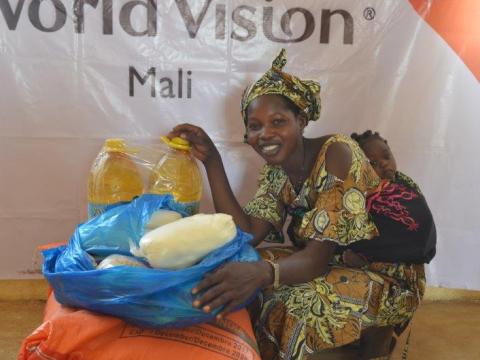Hope on Crisis - Tackling Food Security in Central Mali

According to the Office for the Coordination of Humanitarian Affairs (OCHA) reports, 165,000 children are suffering from malnutrition in the Central Mali Crisis. Reports indicate that visits to local health centers have declined drastically due to insecurity, leading district health and sanitation representatives to fear the worst. A combination of climate change and insecurity since last year has worsened the situation of already vulnerable families in the conflict areas. As a consequence, most families have lost crops, access to their land and their property in general.
The shortage of rain last year in most of the conflict-affected areas has all but erased the posibility of food security for thousands of families. Families like that of one-year old Atou Dembelé. Her mother, a distraught Fatumata Troure (20), mother explains, "I came to the food distribution today because my husband is a rice farmer but last year the harvest was very bad. There wasn’t enough rain to flood the land near the banks of the river Niger where we grow rice. So we were left with nothing to eat. Currently we eat two meals a day, and it’s not sufficient for everyone in the house. We are a total of 15 people living in the house, so the children always complain of not having eaten enough, it really difficult for us.” Fatumata sat, pensive of face, breastfeeding little Atou.
Fatumata is very familiar with child malnutrition. In her village there are a lot of mothers who have had to take their children to the local health center for treatment. "At the local health center, I often see medical staff measuring the arms of the little children. Thank God, they have never done that to my children,” said Fatumata with a contagious smile.
As our exchange continued, the young mother of 3 small children, ages 6, 5 and 1, was very keen to explain her past experience, “In the years that the harvest is good, we have 3 meals a day, and we have enough rice to eat and to sell. With the money from the sale, I used to make small pancakes locally called “galette” out of millet flour to sell.” With the earnings from her small business, Fatumata used to buy soap to wash clothes and pay for the mechanized mill to pound her millet, giving her more time to look after her children. When asked about the security situation, she pauses before answering. “I know that the fear is present, but it’s hasn’t reached our village. I am sure that when it does, my husband will be targeted,” said the 20-year-old mother, with a worried look yet absolute conviction.
Fatumata, with abrupt happiness, talked of her happiness and relief to have benefited from the food assistance for a two-month period. “I received quality today, this is very good for Atou, because she likes milk and pasta. The selection of products we received really meet our needs, especially the rice. Rice is the basis of our diet. I would like to thank World Vision and its partners,” she said, looking straight at me.
Fatumata’s family is one of the lucky ones in this crisis. Reports from OCHA indicate that 800,000 people are projected in Phase 3-4 food insecurity in Mopti Region. At the distribution site last week in Konio village, a rural commune of Dandougou Fakala, 287 families, including Fatumata’s, received two-month food rations containing 50 kilos of rice, 5 liters of cooking oil, 1 kilo of milk powder, 1.5 kilos of sugar, 2 kilos of pasta, I kilo of salt and 5 kilos of cowpeas.
World Vision's Central Mali Emergency Response provides food assistance and livelihoods program, planned to reach 5,000 affected families. Aid is delivered through coordination with distribution and compliance committees established by community members, and in some cases like in this one, in partnership with World Food Program (WFP), in the affected areas.
I am sure you will be glad to know that more children like little Atou will be food secure in the midst this deepening crisis.